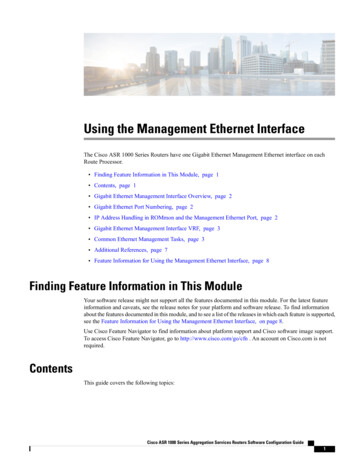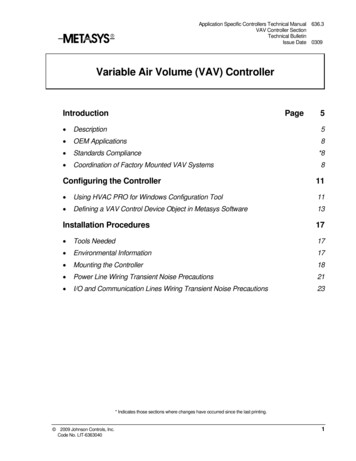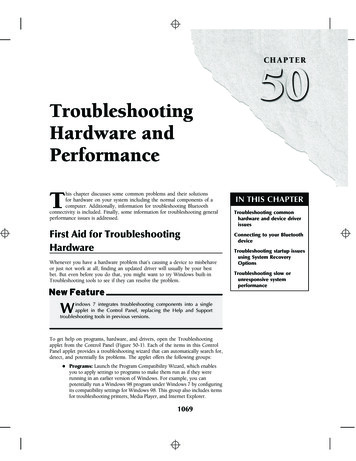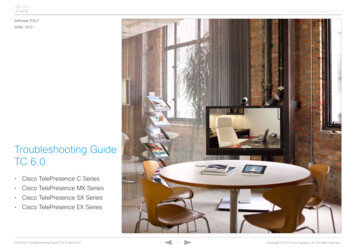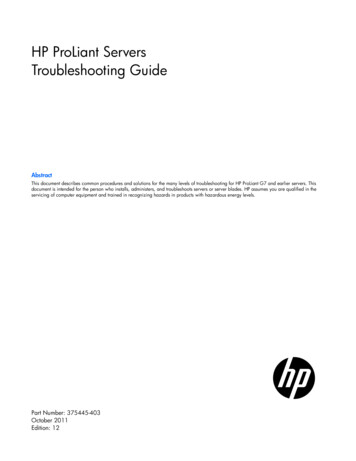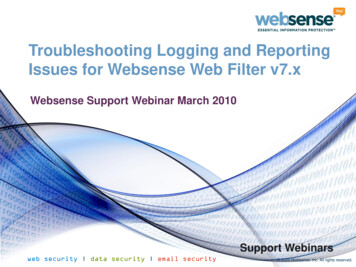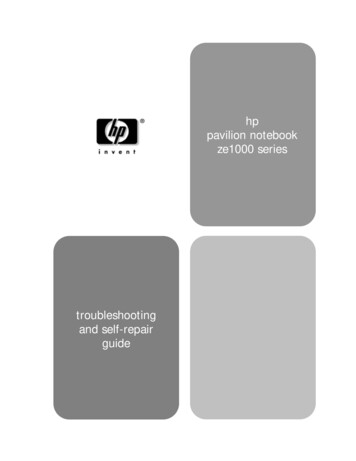
Transcription
T R O U B L E S H O OT I N G V R F26 RSES Journal APRIL 2020w w w. r s e s j o u r n a l . co m
T R O U B L E S H O OT I N G V R FMaintaining andTroubleshootingVRF SystemsYour diligence and expertiseare vital for proper systemperformanceB Y B R I A N D E R R Y,MITSUBISHI ELECTRICT R A N E H VA C U SWhen you service andtroubleshoot variable refrigerant flow(VRF) systems,you’re onsite to ensure the equipmentconsistently gives your customerthe best comfort and performancepossible. You’re not looking to bethe go-to provider for costly, inconvenient callbacks. Accurateload calculations, proper installation practices, commissioningand regular maintenance are howyour customer’s VRF system willlive up to the technology’s reputation for reliable performance andenergy efficiency. Quality productengineering on the manufacturer’spart will get you part of the way,but your diligence and expertiseare vital for proper performance.w w w. r s e s j o u r n a l . co mAPRIL 2020 RSES Journal 27
T R O U B L E S H O OT I N G V R FIf you’ve worked with unitarysystems, you already have much ofthe knowledge and experience youneed to service a VRF system. Youalso have most of the necessarytools and gear. You’re going to perform the normal tasks: clean fi lters,blowers, coils and drains, checkwhat you already know with VRFspecific concepts and training.FundamentalsImproving on the direct-expansion(DX) principle, a VRF system usesvariable-speed motors and electronic expansion valves to cycle re-Compare your documentation of theVRF system that’s described in themanufacturer’s literature to the appliedVRF system that you’re servicing.electrical connections, tightenwires, inspect refrigerant lines and(if necessary) check the refrigerantcharge. VRF technology doesn’tmagically change the foundationalelements of air-conditioning systems, but you’ll need to supplementfrigerant and control transfer heatbetween the outdoor unit and theindoor unit(s) in each zone. Just likea normal heat pump system duringheating, the outdoor unit introduces heat drawn from ambient air ora nearby water source. During cool-ing, the indoor units act as evaporators and send heat to the outdoorunit, where it’s rejected. If the VRFsystem is equipped with a branchcircuit controller, it can also useheat recovery to transfer heat fromzones requiring cooling to zones thatneed heat. Repurposing heat rejectedfrom cooling zones for use in heating zones is known as simultaneousheating and cooling.The variable-speed compressor,and fan motors, located in the outdoor unit enable a VRF system tomodulate refrigerant flow and capacity to match the load and capacity of a single zone or multiplezones that may be calling inside.In contrast, a fi xed-capacity HVACsystem uses the same capacity on amild day as it does on design days.Most of the energy savings associated with VRF systems accrue inpart-load conditions.Continuous Communication and Variable CapacityThe ability of the VRF system tovary capacity is reliant on goodcommunication between all of thesystems components. Without accurate, continuous information fromall system components, the outdoorunit can’t adjust refrigerant flow tomatch internal loads. As a technician servicing VRF equipment, youneed to understand how the components interact and communicatewith each other.While the compressor has thesame mechanical function in bothfixed-capacity and VRF systems,the VRF compressor has different electrical characteristics due tothe inverter that controls its motor speeds. You need to accountfor this during servicing. If you’rechecking pressures or the refrigerant charge, for example, you mayneed to put the system in a specialmode. Most VRF systems allowOutdoor Unit28 RSES Journal APRIL 2020w w w. r s e s j o u r n a l . co m
T R O U B L E S H O OT I N G V R Fbut there are special installation considerations required to maintain theirperformance. You will want to mountthe outdoor unit above the snow lineand keep it from being covered duringa snowstorm. You will need to accountfor defrost and prevent icing beneaththe units and in areas where peoplemay walk. To maximize performance,you will also need to consider wind direction. Heavy winds can reduce system performance and cause poor defrost cycles.Indoor Unit (Ceiling-Cassette)you to overconnect your indoor capacity to outdoor capacity for a convergence load. In this scenario, you canuse a lesser-capacity outdoor unit witha larger-capacity indoor unit, as long asthe unit doesn’t constantly have largercapacity. When checking an overconnected system, it’s imperative that youavoid using more indoor capacity thanyour condenser can handle. For example, if you have a 10-ton outdoorunit and 13 tons of air handlers, youshouldn’t have more than 10 tons ofindoor units running and calling during a test or evaluation.Know the SpecificationsReview and keep manufacturer literature for the products you maintain.Attend manufacturer trainings for thebrands that you intend to service. Although the basic logic is the sameacross systems, VRF manufacturershave different approaches. VRF trainingand literature helps reduce the amountof time it can take to familiarize yourself with a new system.Although a pressure temperaturechart will help you understand superheat and subcooling, in a VRF system these values can change constantly. Also, unlike in a fixed-speed system,you may have distinct superheat andw w w. r s e s j o u r n a l . co msubcooling numbers in different partsof a VRF system.If you’re installing a system, pay special attention to guidelines for clearanceand serviceability. Knowing installationspecifications will help you identify potential problems due to poor installation practices. This also holds true forindoor unit installations as well. Consider proper duct sizing for the ratedstatic pressure of ducted units. MostVRF indoor units are designed to beself-contained with limited ductwork,if any. Make sure that there is enoughspace between indoor units to preventcross airflows or one unit’s supply airdirected at another’s intake or return.VRF heat pumps and heat-recoverysystems run throughout the winter,Document Your InspectionFacility managers and customers arean important source of site-specific details. Start with the basics and workfrom there. How does your system operate? Where are the units located?Where are the thermostats? Can youshow me the controller? Where’s theelectrical disconnect? Where’s the unit’sdrain line and where does it terminate?You will ask questions and perform avisual inspection to identify potentialvulnerabilities.As you directly examine each pieceof equipment, document the details andwhat your customer reveals about the system’s performance. Your visual inspectionand notes are part of the history you oranother technician will use when assessing the VRF system in the future. You’llcompare your documentation of the applied VRF system with the VRF systemas described in the manufacturer’s litera-Branch Circuit ControllerAPRIL 2020 RSES Journal 29
T R O U B L E S H O OT I N G V R FInstallation guidelines on distances between units.ture. Note any apparent deviationsfrom what is expected.Document the cleanliness of theequipment and whether there areany obstructions to drainage or airflow. Also, if available, use manufacturer-provided diagnostic softwareor hardware to obtain an overviewof system components, performanceand past error codes. Some facilitiesmay also have specialty panels andmeters designed to collect performance data such as electrical consumption per unit. You’ll sometimesfind this equipment in facilities using energy allocation to bill individual tenants for energy use.You’ll also want to document howthe VRF system integrates with other systems. Is there a separate building automation system or does thefacility manager control multiplesystems through the VRF controls?What protocols are used for integration? Ask your customer about theirexperience controlling the systems.Communicate with your customer so they’ll understand how you’redeveloping a comprehensive viewand history of how their VRF system has performed. If you have aservice contract with them, you’llupdate your documentation witheach scheduled visit.30 RSES Journal APRIL 2020Cleaning Takes Time andSaves TimeBefore you spend time testing thepressure or airflow, visually inspect outdoor units and indoorunits for cleanliness and obstructions. Some performance indicators are easily impacted by cleanliness. For example, low superheatis often caused by a dirty blowerwheel or a dirty evaporator coil.Unlike traditional fi xed-speed systems, VRF systems have the ability to modulate down and compensate for conditions like this.Th is is where experience andthorough inspections pay off.Spend as much time as you needto thoroughly clean each indoorunit and confirm that drainagepans and lines are clear. Takingan extra 30 seconds to make sureyou haven’t overlooked a detaillike restarting an outdoor unit youturned off during service can saveyour company money and time.Use checklists and follow manufacturer instructions for disassemblyand cleaning processes.Drainage lines are too oftenoverlooked in all systems and especially in VRF systems. Regularlyinspect and flush drain lines to prevent potential backups and leaks.You may also need to perform location-specific cleaning tasks and inspections. If the facility is near thecoast or a salty environment, you’llwant to inspect metal componentsthat could corrode or rust andclean these components. Be familiar with the brands and how theircomponents work. Salt can corrodecoils and electrical connections,which might lead to poor performance and early failures.Training Makes theDifferenceYou might feel as if you’re sacrificing money by taking time outof the field to attend a manufacturer’s training class. But in thelong run, you’ll more than makeup for that cost. You’ll reduce therisk of costly callbacks and you’llbe able to recognize potential issues before they become challenges. As the VRF market continuesto expand, your ability to maintain these systems for optimalperformance and comfort will elevate you above contractors whodon’t have VRF training.Brian Derry is program manager,Technical Service, for MitsubishiElectric Trane HVAC US.w w w. r s e s j o u r n a l . co m
Troubleshooting VRF Systems BY BRIAN DERRY, MITSUBISHI ELECTRIC TRANE HVAC US W hen you service and troubleshoot vari-able refrigerant ow (VRF) systems, you're onsite to en-sure the equipment consistently gives your customer the best comfort and performance possible. You're not looking to be the go-to provider for costly, in-
